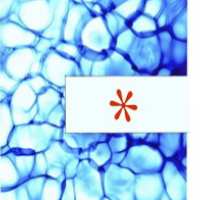Ion acceleration from ultra-thin foils
Other recent experiments include studies of the interaction of one of the most intense lasers in the world, the Vulcan Petawatt laser, with ultra-thin targets of nanometre thickness. In these remarkable, extreme conditions protons and ions can be accelerated up to 10s of MeV per nucleon in accelerating distances of less than a micrometre.
A recent study by the group has demonstrated the formation of Rayleigh-Taylor-like instabilities formed as the ultraintense laser (acting as a ‘light fluid’) exerts its pressure on the plas ma (the ‘heavy fluid’). The instability is imprinted on the proton beam, as can be seen in the image to the right.
ma (the ‘heavy fluid’). The instability is imprinted on the proton beam, as can be seen in the image to the right.
Instead of a smooth proton beam, characteristic of interactions with thick targets, the instability causes holes to form in the plasma through which the laser can propagate, resulting in the visible bubbly structure.


